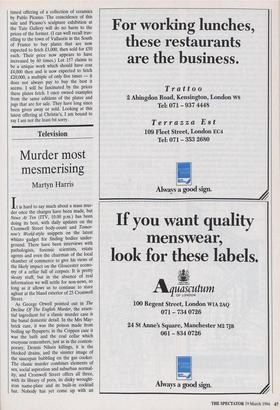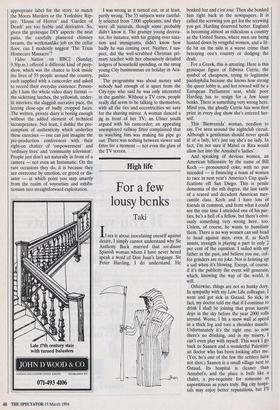Television
Murder most mesmerising
Martyn Harris
It is hard to say much about a mass mur- der once the charges have been made, but News At Ten (ITV, 10.00 p.m.) has been doing its best, with daily updates on the Cromwell Street body-count and Tomor- row's World-style snippets on the latest whizzo gadget for finding bodies under- ground. There have been interviews with pathologists, forensic scientists, estate agents and even the chairman of the local chamber of commerce to give his views of the likely impact on the Gloucester econo- my of a cellar full of corpses. It is pretty sleazy stuff, but in the absence of real information we will settle for non-news, so long as it allows us to continue to stare aghast at the bland exterior of 25 Cromwell Street.
As George Orwell pointed out in The Decline Of The English Murder, the essen- tial ingredient for a classic murder case is the banal domestic detail. In the Mrs May- brick case, it was the poison made from boiling up flypapers; in the Crippen case it was the bath and the coal cellar which everyone remembers, just as in the contem- porary, Dennis Nilsen killings, it is the blocked drains, and the sinister image of the saucepan bubbling on the gas cooker. The classic murder combines elements of sex, social aspiration and suburban normal- ity, and Cromwell Street offers all three, with its library of porn, its dinky wrought- iron name-plate and its built-in cocktail bar. Nobody has yet come up with an appropriate label for the story, to match the Moors Murders or the Yorkshire Rip- per. 'House of Horror' and 'Garden of Death' are too feeble and derivative. So, given the grotesque DIY aspects: the neat patio, the carefully plastered chimney breasts, the workmanlike job on the cellar floor, can I modestly suggest 'The Texas Homecare Massacre'?
Video Nation on BBC2 (Sunday, 9.30p.m.) offered a different kind of peep- show, which was the chance to look inside the lives of 55 people around the country, each supplied with a camcorder and asked to record their everyday existence. Person- ally I hate the whole video diary format the sickening lurches, the yellowish, under- lit interiors; the sluggish narrative pace, the leering close-ups of badly cropped faces. The written, private diary is boring enough without the added element of technical incompetence. Not least, I dislike the pre- sumption of authenticity which underlies these exercises — one can just imagine the pre-production conferences with their right-on chatter of 'empowerment' and `ordinary lives' and 'community television'. People just don't act naturally in front of a camera — not even an Instamatic. On the rare occasions they do, it is because they are overcome by emotion, or greed or dis- aster — at which point you step smartly from the realm of voyeurism and exhibi- tionism into straightforward exploitation. I was wrong as it turned out, or at least, partly wrong. The 55 subjects were careful- ly selected from 7,000 applicants, and they were all naturals, though some probably didn't know it. The grumpy young decora- tor, for instance, with his griping over taxa- tion and immigrants, didn't know how badly he was coming over. Neither, I sus- pect, did the well-scrubbed Christian pri- mary teacher with her obsessively detailed ledgers of household spending, or the smug young City businessman on holiday in Aca- pulco.
The programme was about money and nobody had enough of it apart from the City-type who said he was only interested in the gamble. Without a TV crew, people really did seem to be talking to themselves, with all the tics and eccentricities we save for the shaving mirror. A woman danced a jig in front of her TV; an Ulster youth argued with his camcorder; an appealing unemployed railway fitter complained that us watching him was making his pipe go out. There was nothing between viewer and fitter for a moment — not even the glass of the TV screen.



























































 Previous page
Previous page